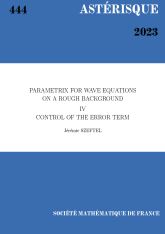Représentations unitaires des groupes de Lie réductifs
Unitary representations of real reductive groups
- Consulter un extrait
- Année : 2020
- Tome : 417
- Format : Électronique, Papier
- Langue de l'ouvrage :
Anglais - Class. Math. : 22E46, 20G05, 17B15
- Nb. de pages : x+177
- ISBN : 978-2-85629-918-0
- ISSN : 0303-1179 (print), 2492-5926 (electronic)
- DOI : 10.24033/ast.1119
Nous présentons un algorithme pour le calcul des représentations unitaires irréductibles d’un groupe de Lie réductif réel $G$. La classification de Langlands, dans sa formulation par Knapp et Zuckerman, présente toute représentation hermitienne comme étant la déformation d’une représentation unitaire intervenant dans la formule de Plancherel. Le comportement de ces déformations est en partie déterminé par l’analyse de Kazhdan-Lusztig des caractères irréductibles; une information plus complète provient de la preuve par Beilinson-Bernstein des conjectures de Jantzen.
Notre algorithme trace à travers cette déformation les changements de la signature de la forme qui peuvent intervenir aux points de réductibilité. Un outil important est une variante de l’astuce unitaire de Weyl : on remplace la forme hermitienne classique (pour laquelle $ \mathrm{Lie}(G)$ agit par des opérateurs antisymétriques) par une forme hermitienne nouvelle (pour laquelle c’est une forme compacte de $ \mathrm{Lie}(G)$ qui agit par des opérateurs antisymétriques).


